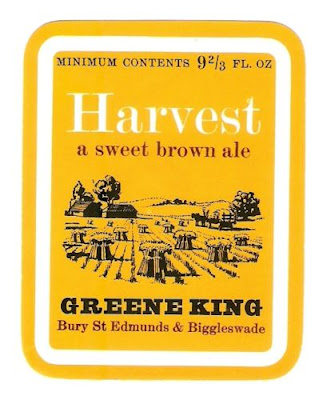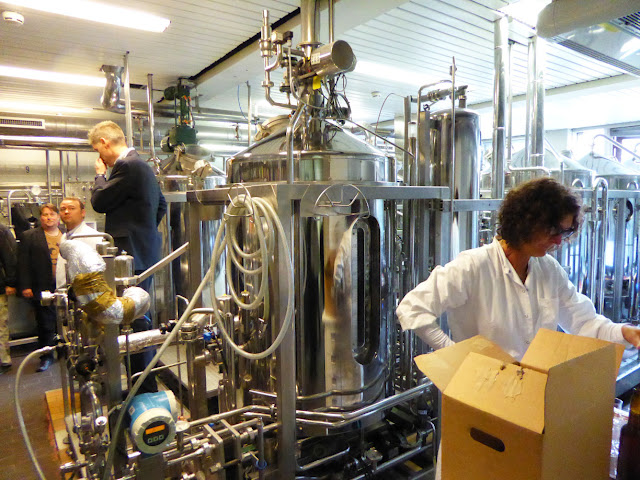Let's be clear right from the start. This was a freebie trip paid for by Carlsberg. They paid for my flight and hotel. Plus other food and drink. It must have come to at least 1,000 euros.
I did consider the ethics of accepting. For about 10 seconds. I love Copenhagen. And Carlsberg's project was right down my street. Plus I got a chance to hang around with some beer writer chums.
The head of Carlsberg Laboratory
What was the project? I hear you ask. An historic beer recreation. I told you it was down my street. More down my street, through my front door and into my living room. During rebuilding work at the brewery they found some old bottles of beer, dating to the early 1880's. They were able to isolate and culture yeast from one of the bottles and decided to try to recreate the beer, Lagerol, from which the yeast came.
pilot brewery
And not by halves. I've had a little experience in the area of recreations and they went about as far as anyone has to be 100% authentic. They got hold of a heritage barley, had it floor malted at a Danish whisky distillery then hand roasted some to create Munich and caramel malt. They brewed it in the 2hl pilot brewery in the laboratory, using a triple decoction mash. It was then aged in a stainless steel tank before being transferred to a wooden cask a week or so before the event. Full marks for effort.
Carlsberg's barley breeding programme
I'll admit to a soft spot for Carlsberg. Whatever you might think of their products today, the brewery played a really important role in brewing history, mostly through its laboratory. Where Hansen perfected pure yeast propagation and Claussen identified Brettanomyces. I got a real thrill standing in the same laboratory as those two great brewing chemists. And getting to talk to their modern successors.
They let me root around in the brewing records last year, too. I'm always grateful to brewers who let me do that.
We got a couple of hours being guided around the lab, then a buffet lunch. All leading up to the main event, the tapping and sampling of the beer.
The brewer got to tap the cask. He looked dead nervous, which I suppose was understandable. He had trouble pouring the beer as it only came out in a trickle. I could see why. Rather than a normal cask tap they were using what looked like a sampling tap with a much narrower outlet.
If I'm honest, the beer was a bit of a let-down. It wasn't conditioned enough and a bit cloudy. It tasted OK, but a bit more fizz would have helped. Ironically, if they'd been less authentic and kegged the beer it probably would have turned out better. But I'm reluctant to criticise them for being too authentic. Maybe they should have got someone from the Tetley side of the business who understands cask conditioning to give them a hand.
When it got to the stage when everyone was hanging around wondering what to do next Jeff said to me: "Do you fancy sloping off down the pub?" He didn't need to ask twice. The afternoon programme was a tour of the brewery then a waterways tour of Copenhagen. I got a private tour of the brewery a year ago. And I know what the centre of Copenhagen looks like. Nothing to detain me until the evening dinner. With the Danish crown prince in attendance.
Jacobsen kettles
We kicked off in Jacobsen, the brewpub inside the old Carlsberg brewery. There was the lovely sweet smell of mashing inside, which set the mood perfectly. Jeff bought a round with his card. He hadn't bothered getting any Danish cash. He had an unfiltered beer while I went for the IPA. It wasn't very IPA-like. Jeff wasn't too impressed with his beer, either. "Tastes like a beer that was meant to be filtered."
A good job they paid travel expenses. I was blankety blank cash-wise. The kids are getting expensive. The week before payday is a time of stress and worry. I still spent over 200 euros. Shows what a pisshead I am because I bought fuck all food. And just one bag of sweets each for the kids. A small jar of anchovies for Dolores. Who says I'm not romantic?
Copenhagen isn't cheap. Unlike me. Though Café Grotten,
where I bought the only round of my stay - for me and Jeff - was just 70
kr. for two half litres. (About the same as one 40cl beer in WarPigs)
Of draught Tuborg we could just about force down. The barman's "You want
draught, not bottled?" should have warned us. And the fact everyone
else was drinking bottles. I'd like to have seen Jeff try paying by card
here.
It's Tuborg, really
Nostalgia time, it was. Me, Jeff, fag smoke and nutters. Like being back in Hebenedanz on that first beer tour with Andy. Me and Jeff share a love of pubs with character and characters. U Rotundy in Prague epitomises that common love. The cast here: a bloke with no teeth playing a slottie, a crazy old Chinese man who randomly grabbed the barman's crotch, a grumpy barman (understandable with the crotch-grabbing), a middle-aged chain smoking woman and - bizarrely - a gorgeous young woman.
It may sound crazy, but I rate the experience higher than seeing the crown prince at the other side of the room. And above most beer pub experiences - Fermentoren is an exception. Meeting the scientists and the brewer and getting to ask my usual questions about lagering times, gravity and ABV satisfied my obsessive side the way bacon fulfils my breakfast lusts.
Fermentoren pretending to be open
Grotten wasn't our first choice. How Jeff peered through the windows on our way past should have tipped me off. Being honest, I was tempted to suggest dropping in, too. We should be more open with each other, I thought. Stop pretending we don't love slumming it. But Fermentoren wasn't open for another half hour.
Not that Fermentoren was in any way crap. Totally different, which is what you want when on a pub crawl, however short. Totally different clientele. But a barman who knew his shit and a friendly local. Then some other beer writers turned up.
I can't help showing off with Jeff. He expects it. Don't want him doubting the hollowness of my legs. That's why I had the 2 pints of Imperial Stout and a double Laphroaig (I asked the price first) in Fermentoren. He'd think me a lesser man if I didn't.
Dinner was a grand affair, held in the villa of Carlsberg's founder. He was a bit of an art collector on the side. Mostly statues of naked ladies, it would appear. The nosh was dead posh, prepared by the former head chef of Noma. Very nice it was. All five mouthfuls. Approximately one mouthful per course. Just as well I wasn't that hungry.
Sitting next to Carlsberg's historian, Bjarke Bundgaard, was pretty cool. We had lots to chat about. And plenty of chance for me to pitch some crazy ideas.
In case you missed it earlier: Carlsberg paid for my trip. For which I duly presented them with my left bollock on arrival.
Husbryggeriet Jacobsen
Gamle Carlsberg Vej 11,
2500 Valby.
Café Grotten
Sønder Blvd. 37,
1720 København V.
Fermentoren
Halmtorvet 29C,
1700 København v.
Tel: 23 90 86 77































































































